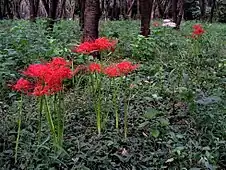Lycoris radiata
Lycoris radiata, known as the red spider lily, hell flower, red magic lily, or equinox flower, is a plant in the amaryllis family, Amaryllidaceae, subfamily Amaryllidoideae.[2] Originally from China, Korea, and Nepal, it was introduced into Japan and from there to the United States and elsewhere. It is considered naturalized in Seychelles and in the Ryukyu Islands.[3] It flowers in the late summer or autumn, often in response to heavy rainfall. The common name hurricane lily refers to this characteristic, as do other common names, such as resurrection lily; these may be used for the genus as a whole.[4]
| Red spider lily | |
|---|---|
 | |
| Scientific classification | |
| Kingdom: | Plantae |
| Clade: | Tracheophytes |
| Clade: | Angiosperms |
| Clade: | Monocots |
| Order: | Asparagales |
| Family: | Amaryllidaceae |
| Subfamily: | Amaryllidoideae |
| Genus: | Lycoris |
| Species: | L. radiata |
| Binomial name | |
| Lycoris radiata (L'Hér.) Herb. | |
| Synonyms[1] | |
| |
Description


Lycoris radiata is a bulbous perennial. It normally flowers before the leaves fully appear on stems 30–70 centimetres (12–28 in) tall. The leaves are parallel-sided, 0.5–1 centimetre (0.20–0.39 in) wide with a paler central stripe. The red flowers are arranged in umbels. Individual flowers are irregular, with narrow segments which curve backwards and long projecting stamens.[5][6][7]
Taxonomy
The presumed original form of Lycoris radiata, known as L. radiata var. pumila, occurs only in China. It is a diploid, with 11 pairs of chromosomes (2N = 22), and is able to reproduce by seed. Triploid forms, with 33 chromosomes, are known as L. radiata var. radiata. These are widespread in China and also in Japan, from where the species was introduced into cultivation in America and elsewhere. The triploid forms are sterile, and reproduce only vegetatively, via bulbs. The Japanese triploids are genetically uniform. It has been suggested that they were introduced into Japan from China along with rice cultivation.[8]
In phylogenetic analyses based on chloroplast genes, Hori et al. found that all the other species of Lycoris they examined were nested within Lycoris radiata. They suggest that the "species" of Lycoris presently recognized may not be distinct.[8]
Cultivation
The plant was first introduced into the United States in 1854, when Japanese ports were opened for US trade. Captain William Roberts, who enjoyed botany, brought back only three bulbs of the red spider lily. The bulbs were then planted by his niece who found that they do not bloom until after the first good rain in the fall season.[9] Plants have since become naturalized in North Carolina, Texas, Oklahoma, and many other southern states of the US.[9] Since the Japanese forms are sterile triploids, the introduced plants were also sterile and reproduce only by bulb division.[10]

Lycoris radiata is not frost-hardy in countries like England, and so can only be grown under glass or in a very sheltered position.[5] In warm-summer climates such as the U.S. east of the Rocky Mountains, where there is sufficient summer heat to harden off the bulbs, the plants are hardy to around 0 °F (−18 °C). Bulbs can be stored in a dry environment between 45–55 °F (7–13 °C) and then planted in the spring in full sun in well-drained soil (e.g. sandy with some clay), 8 inches (20 cm) deep, with 6–12 inches (15–30 cm) between each bulb, and left undisturbed. Plants flower in late summer or early fall, with stems around 24–28 inches (61–71 cm) tall. Leaves follow the flowers, remaining through the winter and disappearing in early summer.[11][12] The flowers fade over the course of a week from brilliant fluorescent red to a deep pink.
Uses and legends
The bulbs of Lycoris radiata are poisonous.[13][14] These are mostly used in Japan, and they are used to surround rice paddies and houses to keep pests and mice away.[4] This is the reason most of them now grow around rivers.[10] The Japanese common name Higanbana (彼岸花, Higan bana) for Lycoris radiata[15] literally means "flower of higan (the other shore of Sanzu River, or a Buddhist holiday around the autumnal equinox)". In Japan the red spider lily signals the arrival of fall. Another popular Japanese name for Lycoris radiata is Manjushage (曼珠沙華, Manjusha-ge or Manjusha-ke),[16] taken from the name of a mythical flower described in Chinese translation of the Lotus Sutra.[17] It is called by over 1000 other local names in Japan.[18]
Many Buddhists will use it to celebrate the arrival of fall with a ceremony at the tomb of one of their ancestors. They plant them on graves because it shows a tribute to the dead. People believe that since the red spider lily is mostly associated with death, one should never give a bouquet of these flowers.[12]
Joya relates their association with Japanese Christian martyrs in medieval times. Their places of martyrdom were said to be marked by these flowers.[19]

Since these scarlet flowers usually bloom near cemeteries around the autumnal equinox, they are described in Chinese and Japanese translations of the Lotus Sutra as ominous flowers that grow in Hell, (Chinese: 黃泉), and guide the dead into the next reincarnation.
Some legends have it that when you see someone that you may never meet again, these flowers, also called red spider lilies or corpse flowers, would bloom along the path. Perhaps because of these sorrowful legends, Japanese people often used these flowers in funerals. Higanbana can be literally taken as the higan (the other or that shore of Sanzu River) flower, decorative and enjoyable, flower of the afterlife in gokuraku jyōdo (極楽浄土, gokuraku jyōdo).
References
- The Plant List
- Stevens, P.F., Angiosperm Phylogeny Website: Asparagales: Amaryllidoideae
- Kew World Checklist of Selected Plant Families
- Knox, Gary W. (2011), Hurricane Lilies, Lycoris Species, in Florida, Environmental Horticulture Department, Florida Cooperative Extension Service, Institute of Food and Agricultural Sciences, University of Florida, retrieved 2012-04-12
- Mathew, Brian (1978), The Larger Bulbs, London: B.T. Batsford (in association with the Royal Horticultural Society), ISBN 978-0-7134-1246-8
- William Herbert. 1819. Botanical Magazine 47: pl. 2113
- L'Héritier de Brutelle, Charles Louis. 1788, Sertum Anglicum 16, as Amaryllis radiata
- Hori, TA; Hayashi, A; Sasanuma, T & Kurita, S (2006), "Genetic variations in the chloroplast genome and phylogenetic clustering of Lycoris species", Genes Genet. Syst., 81 (4): 243–253, doi:10.1266/ggs.81.243, PMID 17038796
- Red Spider Lily, The Southern Bulb Company
- Chandler, Brian (1999–2002), Higabana – red spider lily, archived from the original on 2011-09-13, retrieved 2011-09-13
- Evans, Erv & De Hertough, A.A., Lycoris radiata; Spider lily, Naked lily, Red spider lily, NC State University, archived from the original on 2011-09-13, retrieved 2011-09-13
- Klingaman, Gerald (2000), Plant of the Week : Red Spiderlily, University of Arkansas Division of Agriculture, Cooperative Extension Services, archived from the original on 2011-09-13, retrieved 2011-09-13
- "Lycoris radiata (Amaryllidaceae)". Poisonous plants easily mistaken for harmless ones. Tokyo Food Safety Information Center, Tokyo Metropolitan Government. Retrieved 2019-11-19.
- Tanaka, Tyôzaburô (1976). Tanaka's Cyclopaedia of Edible Plants of the World, cited in "Plants for A Future (pfaf.org)". Japan: Keigaku Publishing. OL 4946828M.
- Yonekura, Koji; Kajita, Tadashi. "Lycoris radiata (L'Hér.) Herb. Japanese name:Higanbana". BG Plants Japanese name - Scientific name Index (YList) (in Japanese). Tropical Biosphere Research Center, University of the Ryukyus. Retrieved 2019-11-19.
- Ito, Atsutaro (1911–1924). "2.5". Dainihon Shokubutsu Zui 大日本植物図彙 (in Japanese). 1. Japan: Dainihon Shokubutsu Zui Shuppansha. pp. 1–5. doi:10.11501/1908225.
- "Wallpaper photographs: Higanbana". The Institute of Vegetable and Floriculture Science (in Japanese). Retrieved 2019-11-19.
- "Aliases of Higanbana". PC club, Kumamoto Highschool (in Japanese). 2010-03-22. Retrieved 2019-11-19.
- Joya, Mock (2017-07-12) [1985]. Japan and Things Japanese. ISBN 9781136221866.
External links
 Media related to Lycoris radiata at Wikimedia Commons
Media related to Lycoris radiata at Wikimedia Commons- "Lycoris radiata." Backyard Gardeners. 2008. Backyard Gardeners. 13 Apr 2009 <http://www.backyardgardener.com/plantname/pda_deae.html>.
- "Lycoris radiata Herbert." Natural Resource Conservation Service. 13 Apr 2009. USDA. 13 Apr 2009 <http://plants.usda.gov/java/profile?symbol=LYRA>.
- Red Spider Lily Photo Gallery
- Li, S; Chen, C; Zhang, H; Guo, H; Wang, H; Wang, L; Zhang, X; Hua, S; Yu, J; Xiao, P (July 2005). "Identification of natural compounds with antiviral activities against SARS-associated coronavirus". Antiviral Research. 67 (1): 18–23. doi:10.1016/j.antiviral.2005.02.007. PMC 7114104. PMID 15885816.